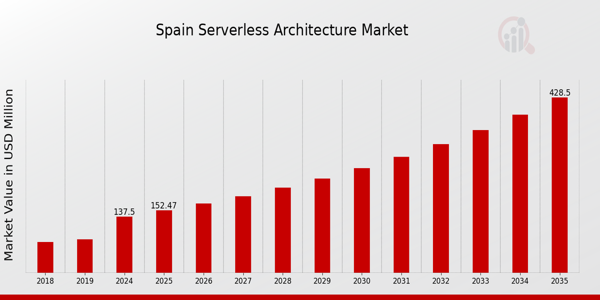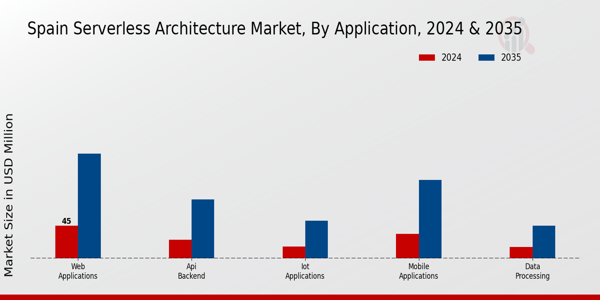Spain Serverless Architecture Market Overview
As per MRFR analysis, the Spain Serverless Architecture Market Size was estimated at 123.75 (USD Million) in 2023.The Spain Serverless Architecture Market Industry is expected to grow from 137.5(USD Million) in 2024 to 428.5 (USD Million) by 2035. The Spain Serverless Architecture Market CAGR (growth rate) is expected to be around 10.886% during the forecast period (2025 - 2035).
Key Spain Serverless Architecture Market Trends Highlighted
The Spain Serverless Architecture Market is witnessing significant growth driven by the rising adoption of cloud computing solutions across various sectors. Businesses in Spain are increasingly seeking flexible and scalable solutions that serverless architecture provides, which allows them to focus on application development without the burden of managing server infrastructure.
The Spanish government's initiatives to digitalize public services and encourage innovation within startups are also driving the adoption of serverless technology. Policies aimed at enhancing digital transformation across industries create a favorable environment for enterprises to explore serverless frameworks.
Moreover, opportunities abound in sectors such as retail, finance, and healthcare, where companies can utilize serverless architecture to enhance operational efficiency and reduce costs. As organizations strive to maintain competitive advantage, the incorporation of serverless solutions enables faster deployment of applications and services, catering to the dynamic needs of consumers in Spain.
In recent times, Spain has seen a marked shift towards microservices architectures as a way to build applications efficiently. This trend complements serverless architecture, as businesses look to break down their applications into smaller, manageable pieces that can scale independently.
As a result, development teams are more agile and can rapidly iterate based on customer feedback. Companies are also increasingly focusing on integrating artificial intelligence and machine learning capabilities within their serverless applications to drive innovation. This synergy showcases Spain’s commitment to being at the forefront of technological advancements and enhancing its competitive landscape within the global market.

Source: Primary Research, Secondary Research, MRFR Database and Analyst Review
Spain Serverless Architecture Market Drivers
Growing Demand for Scalability and Flexibility in Businesses
The market for serverless architecture in Spain is expanding significantly due to the rising need for adaptable and scalable business solutions. Nearly 60% of Spanish companies, according to trade groups, say that their IT operations' requirement for quick scaling is what motivates them to implement innovative technologies, such as serverless architecture. To improve their operational efficiency and offer cutting-edge services, well-known companies like Telefnica and Accenture are making significant investments in serverless solutions.
With an expanding digital economy, Spanish enterprises are increasingly leveraging serverless architecture to cater to fluctuating workloads without significant upfront investments in infrastructure, thereby enhancing their competitive edge. Spain's National Institute of Statistics indicates a steady rise in digital transformation initiatives, with 45% of Spanish firms adopting advanced technological frameworks, thereby supporting the serverless growth trajectory.
Increased Adoption of Cloud Computing Solutions
The shift towards cloud computing solutions is one of the major drivers of growth in the Spain Serverless Architecture Market Industry. Reports from the Spanish government reveal that cloud computing adoption among businesses has increased by over 25% in recent years, highlighting the trend towards outsourcing infrastructure management. Companies like IBM and Microsoft are also enhancing their cloud offerings in Spain, promoting serverless architectures to meet business needs effectively.
The CNMC (National Commission on Markets and Competition) has noted that small and medium enterprises (SMEs) in Spain are particularly benefiting from cloud-based models, allowing them to access advanced computing resources that were previously cost-prohibitive. This trend is expected to continue, fueling future growth in serverless architecture solutions.
Cost-Effectiveness of Serverless Solutions
Cost efficiency is a critical factor contributing to the growth of the Spain Serverless Architecture Market Industry. Businesses in Spain are increasingly opting for serverless models due to the 'pay-as-you-go' pricing structure, which significantly reduces operational costs. A survey by the Spanish Federation of Industries and Services (FES) indicates that companies utilizing serverless solutions reported a reduction in infrastructure costs by as much as 30%.
Major players like Amazon Web Services and Google Cloud are expanding their serverless service offerings in Spain, making it easier for businesses to manage their budgets. As organizations strive to tighten their financial controls, the cost-saving possibilities presented by serverless architecture are becoming an attractive option for many.
Spain Serverless Architecture Market Segment Insights
Serverless Architecture Market Application Insights
The Application segment of the Spain Serverless Architecture Market presents noteworthy opportunities for growth and innovation, reflecting changing business landscapes and technological advancements. As organizations in Spain increasingly adopt cloud computing solutions, the emphasis on Serverless Architecture has risen.
Web Applications wield significant influence in this transformation, delivering seamless user experiences while eliminating the overhead of infrastructure management. Simultaneously, Mobile Applications leverage serverless technologies to enhance scalability and flexibility, critical for catering to the growing mobile user base in Spain.
API Backend plays an essential role in enabling developers to build solutions faster and more efficiently, emphasizing the importance of connectivity in contemporary digital services. Furthermore, IoT Applications are gaining traction in Spain, driven by the proliferation of Internet of Things devices across various sectors, which require robust and scalable back-end solutions to manage data and processes. Data Processing, as part of this segment, underscores the demand for efficient and real-time analytics capabilities, enabling organizations to extract actionable insights from vast datasets generated by different applications.
This versatility across various categories within the Application segment not only supports the increasing digital transformation efforts in Spain but also aligns with the country's goal of becoming a leader in technological innovation in Europe. Overall, the Spain Serverless Architecture Market segmentation underscores a shift towards more agile and cost-effective application development practices, fostering an ecosystem of creativity and efficiency to cater to emerging industry needs.

Source: Primary Research, Secondary Research, MRFR Database and Analyst Review
Serverless Architecture Market Deployment Model Insights
The Spain Serverless Architecture Market has shown a notable division within the Deployment Model segment, primarily consisting of Public Cloud, Private Cloud, and Hybrid Cloud. Public Cloud solutions are becoming increasingly favored due to their scalability and cost-effectiveness, catering well to startups and enterprises looking to reduce operational costs.
Conversely, Private Cloud appeals to organizations with stringent security and compliance requirements, particularly in regulated sectors. Additionally, Hybrid Cloud serves as a versatile option, allowing businesses to enjoy the benefits of both Public and Private Cloud, thereby facilitating data management and application deployment in a manner that aligns with organizational policies.
This segmentation reflects the evolving dynamics of digital transformation across various industries in Spain. As enterprises continue to adopt cloud technology, the need for flexible and efficient deployment models will play a critical role in driving innovation and operational efficiency in the Spain Serverless Architecture Market. The growing trend toward remote work and the digitalization of services further underscore the importance of these deployment models in enhancing responsiveness and agility in the marketplace.
Serverless Architecture Market Service Type Insights
In the Spain Serverless Architecture Market, the Service Type segment encompasses various critical offerings that cater to evolving business needs. Among these, Function as a Service (FaaS) stands out as a popular choice, enabling developers to run code in response to events without provisioning servers, which significantly enhances agility and efficiency. Backend as a Service (BaaS) also plays a vital role, providing backend services like user authentication, database management, and server-side logic, thus reducing development time and operational complexity for startups and established enterprises alike.
Database as a Service (DBaaS) is crucial in facilitating easy management of databases, allowing organizations to focus on application development rather than infrastructure maintenance, attracting businesses seeking scalability. Additionally, Event Streaming has gained traction as it supports real-time data processing, offering organizations the ability to respond immediately to data changes and events, which is essential in today's fast-paced environment. The rising trend of adopting these services aligns with the digital transformation initiatives in Spain, as organizations seek to enhance productivity while managing costs effectively.
This segment reflects a vital shift towards more efficient architectures in the Spain Serverless Architecture Market, driven by the need for agility and scalability in business operations.
Serverless Architecture Market End User Insights
The Spain Serverless Architecture Market has showcased a diverse range of End Users, primarily composed of Small and Medium Enterprises, Large Enterprises, and Startups, each contributing significantly to the overall market dynamics. Small and Medium Enterprises are increasingly leveraging serverless architecture to optimize operational costs and enhance scalability, allowing them to compete effectively in the market.
Large Enterprises are also adopting these solutions, utilizing their flexibility to innovate and deliver products faster while reducing infrastructure management overhead.Startups stand out in this market due to their agility and need for rapid deployment without the burden of initial investments in hardware, making serverless architecture a perfect fit for their business models.
The increasing emphasis on digital transformation across various sectors in Spain further fuels this growth, as organizations recognize the value of operational efficiency and reduced time-to-market. As Spain continues to push towards technological advancement, these End Users will play vital roles in shaping the Spain Serverless Architecture Market, demonstrating how varied company sizes can harmoniously benefit from cloud-native solutions.
Spain Serverless Architecture Market Key Players and Competitive Insights
The Spain Serverless Architecture Market has been seeing a notable transformation as organizations increasingly lean towards agile development practices and seek to enhance operational efficiency. This shift towards serverless computing reflects a growing recognition among businesses that they can significantly reduce the complexities associated with infrastructure management, thereby allowing them to focus more on innovative solutions and core competencies.
The competitive landscape is characterized by a variety of players offering diverse solutions that cater to various needs, ranging from startups to large enterprises. The market dynamics are influenced by technological advancements, regulatory standards, and the growing demand for scalable and cost-effective services. As many companies in Spain start to adopt cloud-native technologies, the serverless architecture has emerged as a key facilitator driving digital transformation initiatives across sectors.
Oracle holds a significant position in the Spain Serverless Architecture Market, primarily through its comprehensive cloud offerings that emphasize high performance and security. The company's strengths lie in its established reputation in enterprise software and databases, which translates well into its cloud services. Oracle's serverless solutions provide flexibility and ease of use, enabling developers to deploy applications without worrying about infrastructure management.
The company's deep integration capabilities allow for seamless connectivity with existing enterprise systems, fostering a conducive environment for businesses to innovate rapidly. Oracle's market presence in Spain is further bolstered by strategic partnerships and continuous investment in local data centers, enhancing reliability and compliance with regional regulations. This commitment positions Oracle favorably among competition, as it appeals to companies looking for robust solutions to support their serverless needs.
Twilio has emerged as an influential player in the Spain Serverless Architecture Market, particularly recognized for its communication platform as a service (CPaaS) that empowers businesses to seamlessly integrate communication functionalities into their applications without the burden of managing server infrastructures. With a range of offerings such as SMS, voice, and video APIs, Twilio ensures that companies in Spain can deliver rich customer engagement experiences.
The company's strength lies in its developer-friendly approach, which encourages rapid application development and deployment, fostering innovation within diverse industries. Twilio has also been active in expanding its market presence through strategic mergers and acquisitions that enhance its capabilities and broaden its service offerings. This positions Twilio as a leader in delivering scalable and reliable serverless architecture solutions tailored to meet the distinct needs of the Spanish market, ensuring that businesses can leverage modern communication methodologies effectively.
Key Companies in the Spain Serverless Architecture Market Include
- Oracle
- Twilio
- Netlify
- Vercel
- Amazon Web Services
- Red Hat
- DigitalOcean
- Mendix
- Cloudflare
- Salesforce
- Heroku
- IBM
- Alibaba Cloud
- Microsoft
- Google Cloud
Spain Serverless Architecture Market Industry Developments
The Spain Serverless Architecture Market has recently witnessed significant growth driven by major companies such as Amazon Web Services, Microsoft, and Google Cloud, capitalizing on the increasing demand for agile and cost-effective cloud solutions. In September 2022, Oracle expanded its cloud infrastructure services in Spain, enhancing its competitive position. Additionally, Twilio announced strategic investments in local startups to foster innovative serverless solutions, further solidifying its commitment to the Spanish market.
The growth in market valuation for companies like DigitalOcean and Netlify reflects an upward trend, as organizations seek scalable solutions to improve their efficiency. Notably, in May 2023, a high-profile acquisition in the serverless sector involved IBM acquiring a local cloud-native company, aimed at strengthening its serverless capabilities tailored for the European market.
The emphasis on serverless technology has also been evident in the Spanish government's digital transformation initiatives, focusing on providing robust cloud services to enhance public sector operations. Recent developments highlight Spain's vibrant tech ecosystem, making it a key player within the broader serverless architecture landscape in Europe.
Spain Serverless Architecture Market Segmentation Insights
-
Serverless Architecture Market Application Outlook
- Web Applications
- Mobile Applications
- API Backend
- IoT Applications
- Data Processing
-
Serverless Architecture Market Deployment Model Outlook
- Public Cloud
- Private Cloud
- Hybrid Cloud
-
Serverless Architecture Market Service Type Outlook
- Function as a Service
- Backend as a Service
- Database as a Service
- Event Streaming
-
Serverless Architecture Market End User Outlook
- Small and Medium Enterprises
- Large Enterprises
- Startups
| Report Attribute/Metric Source: |
Details |
| MARKET SIZE 2023 |
123.75(USD Million) |
| MARKET SIZE 2024 |
137.5(USD Million) |
| MARKET SIZE 2035 |
428.5(USD Million) |
| COMPOUND ANNUAL GROWTH RATE (CAGR) |
10.886% (2025 - 2035) |
| REPORT COVERAGE |
Revenue Forecast, Competitive Landscape, Growth Factors, and Trends |
| BASE YEAR |
2024 |
| MARKET FORECAST PERIOD |
2025 - 2035 |
| HISTORICAL DATA |
2019 - 2024 |
| MARKET FORECAST UNITS |
USD Million |
| KEY COMPANIES PROFILED |
Oracle, Twilio, Netlify, Vercel, Amazon Web Services, Red Hat, DigitalOcean, Mendix, Cloudflare, Salesforce, Heroku, IBM, Alibaba Cloud, Microsoft, Google Cloud |
| SEGMENTS COVERED |
Application, Deployment Model, Service Type, End User |
| KEY MARKET OPPORTUNITIES |
Increased cloud adoption, Enhanced scalability demands, Cost-effective development solutions, Growing microservices integration, Rising AI and ML applications |
| KEY MARKET DYNAMICS |
growing demand for scalability, cost optimization pressures, increasing developer adoption, enhanced application performance, shifts towards microservices architecture |
| COUNTRIES COVERED |
Spain |
Frequently Asked Questions (FAQ):
The Spain Serverless Architecture Market is expected to be valued at 137.5 million USD in 2024.
By 2035, the market is projected to reach a value of 428.5 million USD.
The expected CAGR for the market from 2025 to 2035 is 10.886%.
The Web Applications segment has the highest valuation, estimated at 45.0 million USD in 2024.
The Mobile Applications segment is projected to be valued at 107.5 million USD by 2035.
Key players include Oracle, Amazon Web Services, Microsoft, and Google Cloud among others.
The Data Processing applications are expected to have a market value of 16.0 million USD in 2024.
The market size for IoT Applications is expected to reach 51.5 million USD by 2035.
Challenges include competition among major players and the need for skilled developers in serverless technologies.
Opportunities include the increasing demand for cloud-native applications and the rise of digital transformation in enterprises.
















